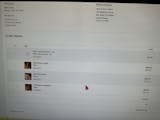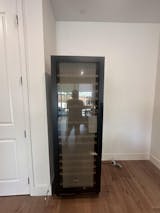-
Purpose of Wine Coolers
The primary purpose of wine coolers is to create a controlled environment that regulates temperature, humidity, and sometimes even light exposure, safeguarding the wine's flavors and characteristics. By keeping wines at consistent temperatures, typically between 45°F to 65°F (7°C to 18°C), wine coolers prevent premature aging or deterioration.
Different Types of Wine Coolers
-
Freestanding Wine Coolers: These stand-alone units are versatile and can be placed anywhere with sufficient space. They offer flexibility in terms of placement but might have limitations concerning capacity and design options.
-
Built-in Wine Coolers: Designed to fit seamlessly into cabinetry or under countertops, these units are excellent for a streamlined look in kitchen spaces or dedicated wine cellars. They often have ventilation requirements specific to their installation location.
-
Dual-Zone Wine Coolers: These coolers feature separate temperature zones within the same unit, allowing storage of different types of wines at their respective optimal temperatures. This versatility is ideal for simultaneously preserving reds and whites or accommodating varied wine preferences.
- Compressor vs. Thermoelectric Wine Coolers:
-
Compressor Wine Coolers: These operate similarly to a standard refrigerator, utilizing a compressor to cool the interior. They tend to be more powerful and suitable for larger capacities but may produce more noise and slight vibrations.
-
Thermoelectric Wine Coolers: These units employ a different cooling mechanism without moving parts, making them quieter and generating minimal vibrations. They are more energy-efficient but might be better suited for smaller collections due to their cooling limitations
- Capacity and Size
Selecting the right wine cooler size and capacity is pivotal in ensuring your collection fits comfortably while maximizing the available space. Here's a guide to assist in making an informed decision:
Determining the Right Size
-
Number of Bottles vs. Available Space: Consider the number of wine bottles you intend to store and measure the available space for the wine cooler. Check the dimensions of the wine cooler units, accounting for both width and height, to ensure it fits into the designated area.
-
Types of Bottles: Remember that wine bottle shapes and sizes can vary (standard, magnum, champagne, etc.). Check whether the cooler's stated bottle capacity accommodates the types of bottles you predominantly have in your collection.
Explanation of Bottle Capacities
-
Standard Bottle Capacities: Wine coolers are typically labeled with their bottle capacity, ranging from smaller units holding around 6 to 12 bottles to larger ones capable of storing 50 or more bottles. This capacity varies based on the standard 750ml wine bottle size.
-
Adjustable Shelves and Flexibility: Some wine coolers offer adjustable or removable shelves to accommodate larger or irregularly shaped bottles, providing flexibility in storage options.
-
Consideration of Variations: Keep in mind that advertised bottle capacities might differ based on the arrangement and types of bottles stored. For instance, if a wine cooler claims to hold 30 bottles, this number could vary if larger or irregularly shaped bottles are included.
Understanding the relationship between the capacity specified by the manufacturer and the practical limitations based on bottle types and sizes will help in making a well-informed decision regarding the appropriate size of the wine cooler for your specific needs.
- Temperature Control
Maintaining precise and consistent temperatures is pivotal for preserving the quality and flavors of your wine collection. Understanding temperature control options and their implications can greatly enhance the storage experience.
Importance of Temperature Consistency and Control
-
Preserving Wine Quality: Temperature consistency is crucial for preventing premature aging, oxidation, or spoilage of wines. Fluctuations in temperature can negatively impact the chemical composition, altering the taste, aroma, and overall quality of the wine.
-
Recommended Storage Temperatures: The ideal temperature range for wine storage typically falls between 45°F to 65°F (7°C to 18°C), varying depending on the type of wine. Red wines generally fare better at slightly warmer temperatures than whites, but both benefit from stable conditions.
Dual-Zone vs. Single-Zone Wine Coolers
-
Single-Zone Wine Coolers: These units maintain a uniform temperature throughout the interior, ideal for those primarily storing one type of wine or not concerned with precise temperature variations. They are simpler in design and often more budget-friendly.
-
Dual-Zone Wine Coolers: Designed with two separate compartments or temperature zones, these coolers offer the flexibility to store different types of wine at their respective ideal temperatures. This feature caters to enthusiasts with diverse wine collections, allowing reds and whites to be stored in optimal conditions simultaneously.
Advantages of Each:
-
Single-Zone Advantages: Simplicity in design and typically more straightforward to operate. Suited for those who predominantly collect one type of wine or don't require temperature differentials.
-
Dual-Zone Advantages: Offers versatility by catering to different wine types or aging requirements simultaneously. Ideal for wine enthusiasts with varied collections or those who appreciate nuanced storage conditions.
- Cooling Technology
Understanding the underlying cooling mechanisms in wine coolers—specifically, compressor-based and thermoelectric systems—can significantly impact the choice of the right unit for your wine storage needs.
Explanation of Compressor-Based and Thermoelectric Cooling Systems
- Compressor-Based Cooling Systems:
-
Functionality: Similar to traditional refrigerators, compressor-based wine coolers utilize a compressor and refrigerant to cool the interior. They actively pump coolant through the system, generating colder temperatures.
-
Performance: Known for their robust cooling capabilities, compressor systems can reach lower temperatures more efficiently. They're suitable for larger wine collections and maintain consistent temperatures even in warmer ambient environments.
-
Considerations: These units may produce a low level of noise due to compressor operation and may generate slight vibrations, potentially affecting sediment in older wines.
- Thermoelectric Cooling Systems:
-
Functionality: Thermoelectric wine coolers operate using the Peltier effect, where electricity powers heat transfer between two conductive surfaces, creating a cooling effect. They have no moving parts, resulting in quieter operation.
-
Performance: These systems are generally quieter and produce minimal vibrations compared to compressor-based units. They are often more energy-efficient and suitable for smaller wine collections or environments where noise levels are a concern.
-
Considerations: Thermoelectric coolers might have limitations in cooling capacity compared to compressor units. They might struggle to maintain low temperatures in warmer surroundings.
Pros and Cons of Each Cooling Technology
- Compressor-Based Cooling:
- Efficient cooling for larger collections.
- Effective in warmer ambient temperatures.
- Widely available and diverse in size/capacity.
- Potential noise and vibration.
- Higher energy consumption compared to thermoelectric units.
- Thermoelectric Cooling:
- Quieter operation with minimal vibrations.
- Energy-efficient and eco-friendly.
- Suitable for smaller collections or noise-sensitive environments.
- Limited cooling capacity in warmer environments.
- Less effective for larger wine collections or in high ambient temperatures.
- Design and Features
The design and features of wine coolers encompass various aspects, from aesthetics to practical functionalities that can enhance the storage experience for wine enthusiasts.
Aesthetics and Design Considerations
- Color, Material, and Door Type:
-
Color and Finish: Wine coolers come in diverse colors and finishes, allowing buyers to match their decor or personal preferences.
-
Material: Consider units made from stainless steel, wood, or other materials, offering durability and visual appeal.
-
Door Type: Some wine coolers feature glass doors, allowing for an elegant display of the collection. However, UV protection or tinted glass might be necessary to shield wine from harmful light exposure.
Shelving Options and Configurations
- Shelving Material and Adjustability:
-
Materials: Shelves can be made from wire, wood, or metal. Opt for units with adjustable or removable shelves to accommodate different bottle sizes and configurations.
-
Sliding vs. Stationary Shelves: Consider the convenience of sliding shelves for easier access versus stationary shelves for stability.
Interior Lighting and Its Impact on Wine Storage
- Purpose of Interior Lighting:
-
Showcasing Collection: Interior lighting enhances the aesthetic appeal by illuminating the wine collection, making it visible without the need to open the door.
-
Impact on Wine: While adding to the visual appeal, excessive or harsh lighting can potentially harm wine quality by causing UV damage. Look for cool LED lights or options with UV protection to maintain optimal storage conditions.
Additional Features to Consider:
-
Digital Controls: Intuitive temperature controls and digital displays for easy monitoring and adjustment.
-
Locks and Security: Some units offer lock features to secure valuable collections.
-
Reversible Door: Ideal for versatile installation options.
-
Humidity Control: Units with humidity control mechanisms can help preserve cork integrity and prevent wine oxidation.
- Energy Efficiency and Noise Levels
When choosing a wine cooler, considering energy efficiency and noise levels is crucial for both environmental impact and user experience.
Information about Energy-Efficient Models
-
Benefits of Energy Efficiency:
-
Lower Operating Costs: Energy-efficient models consume less electricity, leading to reduced utility bills over time.
-
Environmental Impact: They contribute to a lower carbon footprint by conserving energy resources and reducing greenhouse gas emissions.
-
Energy-Efficient Features:
-
Energy Star Ratings: Look for units with Energy Star certification, indicating adherence to stringent energy efficiency standards.
-
Insulation Quality: Well-insulated units maintain consistent temperatures more effectively, reducing the workload on the cooling system and consequently saving energy.
Consideration of Noise Levels
-
Impact of Noise on Placement:
-
Quiet Operation: Some wine coolers, especially those with thermoelectric cooling systems, operate quietly without producing noticeable vibrations or noise.
-
Placement Considerations: Noise levels can be crucial, especially if the wine cooler is intended for installation in living areas or noise-sensitive spaces like bedrooms or home offices.
Sustainability Considerations
-
Environmental Impact: Opting for an energy-efficient wine cooler not only reduces electricity consumption but also contributes to a more sustainable lifestyle by conserving resources and minimizing carbon emissions.
-
Manufacturing Practices: Consider brands or manufacturers committed to sustainability by using eco-friendly materials, employing energy-efficient production methods, and reducing their environmental footprint.
-
End-of-Life Disposal: Look for information on proper disposal or recycling options for the wine cooler at the end of its life cycle to minimize environmental impact.
Choosing an energy-efficient model not only saves costs in the long run but also aligns with sustainable practices, contributing positively to the environment.
- Installation and Placement
Proper installation and placement of your wine cooler are crucial to ensure optimal performance, longevity, and convenience in accessing your wine collection.
Guidelines for Proper Installation
- Ventilation Requirements:
-
Space Clearance: Allow sufficient space around the wine cooler for adequate ventilation. Check the manufacturer's guidelines for recommended clearance from walls or other appliances.
-
Ventilation Direction: Some units require specific ventilation directions (rear or top), so understanding these requirements is essential for efficient operation.
-
Level Surface: Ensure the installation surface is level to prevent the wine cooler from vibrating or rocking during operation.
Placement Options and Considerations
- Kitchen Placement:
-
Convenience: Placing the wine cooler in the kitchen offers convenience for easy access while cooking or entertaining.
-
Temperature Consideration: Ensure the kitchen environment doesn't experience extreme temperature fluctuations or excess heat, which might affect the wine's quality.
- Cellar or Dedicated Wine Room:
-
Ideal Conditions: Wine cellars or dedicated wine rooms often provide optimal conditions for wine storage due to consistent temperature and humidity levels.
-
Considerations: Adequate insulation, humidity control, and temperature stability are key factors to consider in these spaces.
- Living Area or Entertainment Space:
-
Aesthetic Appeal: Placing the wine cooler in a living area or entertainment space can serve as a decorative element, showcasing your collection.
-
Noise Level Consideration: Consider noise levels if the wine cooler operates audibly in these shared living spaces.
Additional Tips:
-
Electrical Outlet Accessibility: Ensure easy access to a power source for the wine cooler.
-
Level Ground: Install the wine cooler on a stable, level surface to prevent vibrations and maintain proper functioning.
- Maintenance and Cleaning
Regular maintenance and proper cleaning practices are essential to ensure the longevity and optimal performance of your wine cooler.
Tips for Regular Maintenance and Cleaning
-
Regular Checkups:
-
Temperature Monitoring: Regularly check and monitor the internal temperature using the wine cooler's built-in display or a separate thermometer to ensure it remains within the desired range.
-
Inspect Seals and Gaskets: Check door seals and gaskets for any signs of wear or damage that could compromise the unit's ability to maintain consistent temperatures.
-
Cleaning Routine:
-
Interior Cleaning: Use a mild solution of water and a gentle detergent to clean the interior surfaces, shelves, and racks. Avoid using harsh chemicals that may affect the wine or the cooler's components.
-
Exterior Maintenance: Wipe down the exterior of the wine cooler regularly using a soft cloth and mild detergent. Avoid abrasive cleaners or solvents that might damage the finish.
Suggestions for Extending the Lifespan of the Appliance
-
Proper Ventilation: Ensure proper ventilation around the unit by keeping the area clear of obstructions. This allows the wine cooler to function optimally without strain.
-
Avoid Overloading: Avoid overloading the wine cooler beyond its recommended capacity. Overcrowding can affect airflow and compromise cooling efficiency.
-
Regular Defrosting (for certain models): If your wine cooler requires defrosting, follow the manufacturer's recommendations for defrosting cycles to prevent ice buildup.
-
Scheduled Maintenance Checks: Consider scheduling periodic professional maintenance checks to ensure all components are working correctly and efficiently.
-
Power Cycling: In case of power outages, allow the unit to stabilize before turning it back on to avoid potential damage from power surges.
- Warranty and Support
Understanding the warranty coverage and after-sales support provided by manufacturers is crucial when investing in a wine cooler. It ensures peace of mind and assistance in case of any unforeseen issues.
Explanation of Warranty Coverage
-
Manufacturer's Warranty: Most wine cooler manufacturers offer warranties that cover defects in materials and workmanship for a specific period. This coverage can range from one to several years, varying among brands and models.
-
Components Covered: Warranty coverage typically includes the compressor, cooling system, and other essential parts. Specifics regarding what is covered and excluded can be found in the warranty documentation provided by the manufacturer.
Importance of After-Sales Service and Customer Support
-
Reliable Customer Support: Manufacturers providing responsive and efficient customer support play a significant role in addressing queries, troubleshooting issues, and providing guidance on maintenance or repairs.
-
Ease of Access: Consider manufacturers that offer easily accessible customer support channels, such as hotlines, email support, or online chat, ensuring prompt assistance when needed.
-
Authorized Service Centers: Brands with an established network of authorized service centers or technicians facilitate convenient repairs or servicing in case of issues covered under warranty.
Factors to Consider Regarding Warranty and Support
-
Duration and Coverage: Compare warranty durations and what aspects are covered to choose a wine cooler with a warranty that aligns with your expectations.
-
Reputation and Reviews: Research the brand's reputation for honoring warranties and providing reliable after-sales service. Customer reviews can provide insights into their responsiveness and support quality.
-
Extended Warranty Options: Some manufacturers offer extended warranty plans for additional coverage beyond the standard warranty period. Assess whether these options are beneficial for added peace of mind.
Choosing a Reliable Warranty and Support System
- Prioritize manufacturers known for standing behind their products with comprehensive warranties and responsive customer support.
- Read and understand the warranty terms and conditions to be aware of what is covered and any specific maintenance requirements.
A robust warranty and reliable after-sales support from the manufacturer are essential factors in ensuring a satisfying ownership experience and long-term satisfaction with your wine cooler purchase.
- 12. Tips for Choosing the Right Wine Cooler
Before making a purchase decision, considering key factors will assist in selecting a wine cooler that aligns with your specific needs and preferences.
Key Points to Consider
-
Capacity and Size: Determine the number of wine bottles you intend to store and measure the available space for the wine cooler. Choose a unit that accommodates your collection size and fits into the designated area.
-
Temperature Control: Decide between single-zone or dual-zone units based on whether you primarily store one type of wine or require different temperature settings for diverse collections.
-
Cooling Technology: Understand the differences between compressor-based and thermoelectric systems and choose one that suits your preferences regarding noise, energy efficiency, and cooling capacity.
-
Design and Features: Consider the aesthetics, shelving options, door type, and interior lighting that match your style preferences and offer convenience in accessing and showcasing your wine collection.
-
Energy Efficiency and Noise Levels: Opt for an energy-efficient model that aligns with your sustainability goals and consider noise levels if the wine cooler will be placed in living areas.
-
Installation and Placement: Ensure proper ventilation, space clearance, and choose a suitable location based on the available space, environmental conditions, and noise considerations.
-
Maintenance and Warranty: Assess maintenance requirements, cleaning routines, and warranty coverage to ensure proper care and support for your wine cooler over time.
Personal Preferences and Collection Needs
-
Wine Collection Diversity: If you have a varied collection of wines (reds, whites, champagne), consider a dual-zone cooler for storing them at their respective optimal temperatures.
-
Aesthetics and Space: Balance the design aesthetics with available space and installation preferences, ensuring the wine cooler complements your home decor.
-
Long-Term Investment: Consider the wine cooler as a long-term investment. Choose a reliable brand with good warranty coverage and after-sales support for a satisfying ownership experience.
Final Consideration
Before finalizing your purchase, prioritize the features and functionalities that best suit your storage needs, space constraints, and personal preferences. Careful consideration of these factors will lead to selecting a wine cooler that safeguards and enhances your wine collection effectively.
FAQ’s”
Q: What temperature should I set my wine cooler to?
A: The ideal temperature for wine storage varies based on the types of wine you're storing. Generally, a range between 45°F to 65°F (7°C to 18°C) is suitable. Whites are often stored at cooler temperatures, while reds might prefer slightly warmer settings. Dual-zone coolers allow for separate temperature settings to accommodate both types.
Q: Can I use a regular refrigerator for wine storage?
A: While a regular refrigerator might work in the short term, it's not ideal for long-term wine storage. Regular fridges are colder and drier than necessary for wines, which can impact their flavors and aromas negatively. Wine coolers provide the optimal conditions needed for wine preservation.
Q: How many bottles can a wine cooler hold?
A: Wine cooler capacities vary based on size and design. They can typically hold anywhere from 6 to over 100 bottles, depending on the model and bottle sizes. Be sure to consider the unit's stated capacity and adjust for different bottle shapes and sizes.
Q: Do wine coolers make noise?
A: The level of noise produced by wine coolers can vary depending on the cooling technology. Thermoelectric units are generally quieter than compressor-based ones. Noise levels are often minimal and comparable to the hum of a refrigerator. Consider this factor when deciding on placement in noise-sensitive areas.
Q: Do wine coolers need special installation requirements?
A: Wine coolers may require specific installation considerations, such as proper ventilation, clearance space, and electrical requirements. Built-in units might need additional considerations for proper airflow. Refer to the manufacturer's guidelines for installation instructions.
Q: How do I clean and maintain a wine cooler?
A: Regular cleaning involves using a mild detergent and soft cloth for the interior and exterior surfaces. Avoid harsh chemicals that could affect the wine or cooler components. Periodic maintenance includes checking seals, temperature monitoring, and ensuring proper ventilation.
Q: Can I use a wine cooler outdoors?
A: It's not advisable to use a standard wine cooler outdoors unless it's specifically designed for outdoor use. Outdoor conditions can impact the cooler's efficiency and lifespan. If considering an outdoor installation, opt for models explicitly built for outdoor environments.
Q: Are wine coolers energy efficient?
A: Many wine coolers are designed to be energy efficient, especially those with thermoelectric cooling systems. Energy efficiency varies among models, so look for Energy Star ratings or manufacturer-provided efficiency information to make an informed choice.
Q: Can I store other beverages in a wine cooler?
A: While primarily designed for wine, some coolers can be used to store other beverages like beer or soft drinks. Ensure the cooler's temperature range accommodates the beverages you intend to store without affecting the wine's storage conditions.
Q: Do wine coolers require special electrical outlets?
A: Wine coolers typically require a standard electrical outlet. However, it's crucial to ensure the outlet is properly grounded and can handle the cooler's power requirements. Avoid using extension cords or sharing outlets with other high-powered appliances.









